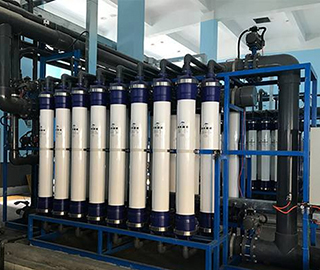Brief introduction of EDI pure water equipment working principle2
Issuing time:2019-10-18 13:29 EDI is a pure water manufacturing technology which combines ion exchange technology, ion exchange membrane technology and ion electromigration technology. It is a new desalting technology which combines electrodialysis and ion exchange. This technology can achieve high desalination effect through ion exchange resin and selective ion membrane, and the combined process with reverse osmosis can make the water quality reach 10-15m Ω desalination effect. The resin bed uses the direct current applied at both ends of the chamber for continuous regeneration. The voltage makes the water molecules in the inlet water decompose into H + and oh -, and these ions in the water are attracted by the corresponding electrode and migrate to the corresponding membrane through the cation and anion exchange resin. When these ions enter the concentration chamber through the exchange membrane, H + and oh - combine to form water. The generation and migration of H + and oh - is the mechanism of continuous regeneration of resin. When the impurities such as Na + and CI - in the influent are adsorbed on the corresponding ion exchange resin, these impurities will undergo the same ion exchange reaction as in the ordinary mixed bed, and H + and oh - will be replaced accordingly. Once the impurity ions in the ion exchange resin are added to the H + and oh - migration towards the exchange membrane, these ions will continue to pass through the resin until they pass through the exchange membrane and enter the concentrated water chamber. Due to the barrier effect of the adjacent compartment exchange membrane, these impurity ions cannot further migrate to the corresponding electrode direction, so the impurity ions can be concentrated in the concentrated water chamber, and then the concentrated water containing impurity ions can be discharged from the membrane stack. All along, the preparation of pure water is at the cost of a large amount of acid and alkali consumption. In the process of production, transportation, storage and use, acid and alkali will inevitably cause environmental pollution, corrosion of equipment, and even harm to human body. At the same time, the cost of equipment maintenance is also high. The wide use of reverse osmosis and electric desalting technology will bring a revolutionary change to the preparation of pure water. EDI module fills ion exchange resin between anion / cation exchange membrane to form EDI unit. In EDI module, a certain number of EDI units are separated by grid to form concentrated water chamber and fresh water chamber. In addition, both ends of the unit group are provided with negative / positive electrodes. Driven by direct current, the anions and cations in the water flow through the anion exchange membrane enter the concentrated water chamber and are removed in the fresh water chamber. The water in the concentrated water chamber will take the ions out of the system and become the concentrated water. Generally, the pure water of secondary reverse osmosis (RO) is used as EDI water supply for EDI equipment. RO pure water resistivity is generally 40-2 μ s / cm (25 ℃). EDI pure water resistivity can be as high as 18 m Ω. Cm (25 ℃), but according to the deionized water use and system configuration settings, EDI ultra pure water is suitable for the preparation of pure water with resistivity of 1-18.2m Ω. Cm (25 ℃). EDI technology is widely accepted by pharmaceutical industry, microelectronics industry, power generation industry and laboratories. It is widely used in surface cleaning, surface coating, electrolysis industry and chemical industry.
|


